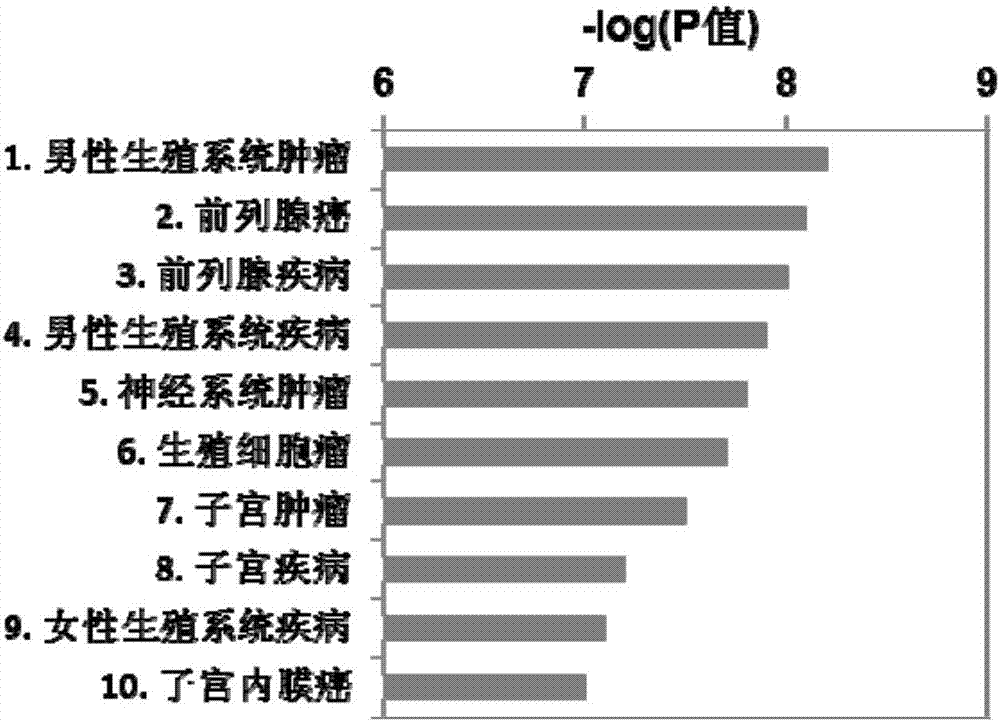Method for assessing risk of endosulfan in cancer promoting
An endosulfan and risk technology, which is applied in the fields of biochemical equipment and methods, microbial determination/inspection, instruments, etc., can solve the problems such as the impact of the accuracy of the results, the limitation of the number of studies, etc., and achieves a simple method, high correlation, and rapid evaluation. Effect
- Summary
- Abstract
- Description
- Claims
- Application Information
AI Technical Summary
Problems solved by technology
Method used
Image
Examples
Embodiment 1
[0027] (1) Endosulfan causes changes in differentially expressed genes in vascular endothelial cells:
[0028] Endosulfan exposure treatment was performed on vascular endothelial cells (HUVEC-C), and the experiment was divided into two groups: DMSO control group (dimethyl sulfoxide, D) and endosulfan experimental group (endosulfan, ES). The concentration of DMSO in the control group was 0.1%, the exposure concentration of endosulfan was 20 μM, and the exposure time was 48 hours. The cells were collected to extract total RNA for gene chip [Agilent Human Gene Expression Profiling, Shanghai Kangcheng Biological Co., Ltd., Whole Human Genome Oligo Microarray (4x44K, Agilent Technologies )] analysis, through gene expression profiling analysis, it was found that compared with the control group, 457 genes were down-regulated and 319 genes were up-regulated when exposed to endosulfan.
[0029] (2) Predictive analysis of human diseases caused by endosulfan exposure:
[0030] For the d...
Embodiment 2
[0034] (1) Gene expression profiling analysis of human prostate cancer:
[0035] In order to study the correlation between endosulfan and prostate cancer, a study on the gene expression profile of prostate cancer was screened out in the NextBio database according to the research species of human, the data type of gene chip data, and the common differential gene correlation P value less than 0.05. Clinical research data (from Stanford Microarray Database, GSE3933; URL http: / / genome-www5.stanford.edu / stanford university, document screenshots such as image 3 ). The data is provided by the Stanford University database, which contains the gene expression profiles of 62 prostate cancer tissues, 41 normal prostate tissues and 9 lymph node metastatic cancers. About 26,000 genes were detected in the whole study, and the prostate cancer tissues were compared with the normal ones. Compared with prostate tissue, there were 7767 genes with differential expression changes.
[0036] (2...
Embodiment 3
[0043] Endosulfan Exposure Causes Changes in PRL-3 Expression Levels:
[0044] Prostate cancer PC3 cells were exposed to endosulfan, and the experiment was divided into two groups: DMSO control group (dimethyl sulfoxide, D) and endosulfan experimental group (endosulfan, ES). The concentration of DMSO in the control group was 0.1%, the exposure concentration of endosulfan was 20 μM, and the exposure time was 48 hours. The cells in the DMSO group and the endosulfan experimental group were collected, and the total RNA was extracted by Trizol method, and the RNA concentration was determined and RNA quality inspection was carried out. The SYBR green (Applied Biosystems, ABI) method was used to carry out qRT-PCR reaction, and the primers (PRL-3 and GAPDH, see Table 2) were designed, GAPDH was used as an internal reference, and 2 -ΔΔCt Methods The differences in mRNA expression were expressed by the multiple of treated samples relative to untreated samples. The result is as Figure...
PUM
 Login to View More
Login to View More Abstract
Description
Claims
Application Information
 Login to View More
Login to View More - R&D
- Intellectual Property
- Life Sciences
- Materials
- Tech Scout
- Unparalleled Data Quality
- Higher Quality Content
- 60% Fewer Hallucinations
Browse by: Latest US Patents, China's latest patents, Technical Efficacy Thesaurus, Application Domain, Technology Topic, Popular Technical Reports.
© 2025 PatSnap. All rights reserved.Legal|Privacy policy|Modern Slavery Act Transparency Statement|Sitemap|About US| Contact US: help@patsnap.com



